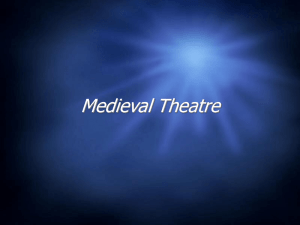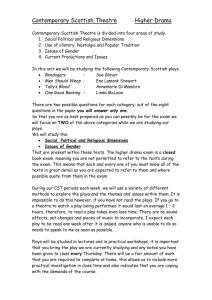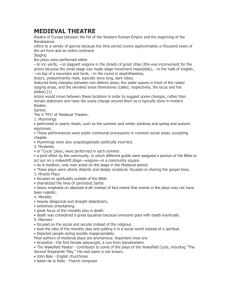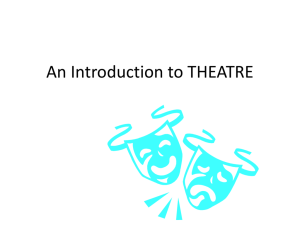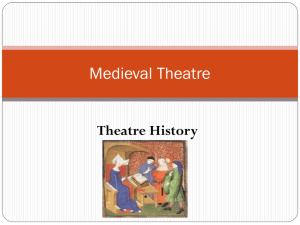Chapter 13
advertisement
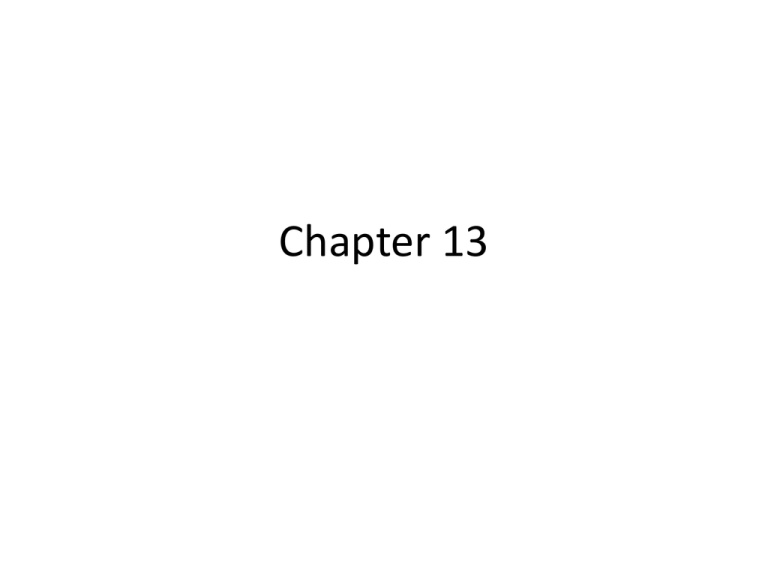
Chapter 13 Context • Medieval theatre came between Roman theatre and the Renaissance • Considered to be a “lower” period of theatre between two higher ones • Feudal system Life of the peasant • Christian Church hierarchy began to weaken Early Medieval Drama and Theatre • What factors in the society pulled theatre toward its central position in the Middle Ages? • Plays of Hroswitha • Liturgical manual of Ethelwold Hroswitha • Wrote 7 plays, the first in existence since the early days of Rome • Based on comedies of Terence • Intended to celebrate chaste maidens • She lived next to the Benedictines in what is now modern Germany – First known female playwright – First known as post-Roman playwright – Intellectual community • Accomplishments often overshadowed Ethelwood • Bishop of Winchester (also Benedictine) • Wrote Regularis Concordia- monastic guidebook, describing how liturgical services were to be performed – – – – – – Music Calendar Vestments Art Architecture Liturgy Medieval Conventions • What were the major conventions of the Middle Ages? How did each reflect the culture of which it was a part? – Simultaneous-several different locations were present – Emblematic-costumes and properties were signs and symbols communicating meaning – Environmental-performed in available space, rather than a structure built for acting Other Dramatic Evolutions • Quem Quaeritis-liturgical dramas performed in the church as part of the liturgy • Latin music drama-plays that were chanted, sung and acted by clergy, choirboys, monks and other scholars – Longer and varying complexity compared to Quem Quaeritis – Biblical • Produced by the church • Costumes based on church vestments • At first monastic communities were the audience and then general audiences attended Culture and Theatre • Commercial Theory c. 1200 – Merchants began to emerge from the feudal system; monopolies and profit-makers replaced the hierarchy of peasants and lords – Reformation in the church because of erosion of faith matters Religious Drama outside the Church • In addition to the Latin music drama, drama outside the church • Performed outdoors • Spoken • Vernacular was used • Laymen involvement • Far-ranging themes; not just liturgical sources • Corpus Christi plays performed in the spring and summer Religious Plays • The plays that remained in the “religious” category – Told of the events of Christ’ life and Old Testament stories; called mystery plays – Lives of saints (historical or legendary); called miracle plays – Didactic allegories (teaching metaphors); called morality plays Shared Characteristics • Teach or reinforce belief in church doctrine • Formulated as melodramas or divine comediesethical system was clear-good rewarded and evil punished • Driving force of action was God and his plan rather than actions of dramatic agents (motivation); appears more episodic in nature – Strength of sin, power and compassion of God, punishment of unrepentant sinners • Cycle plays or cosmic dramas-showed history and took days or weeks to perform (serialized) Staging Religious Plays • Guilds and confraternities- helped to produce plays • All male members (in France women were sometimes permitted to perform) • No written history for 1400-1500 about acting • Conventions remained the same – Fixed Staging- used throughout Europe – Movable Staging-most often used in Spain and England • Fixed stages used mansions or scaffolds- see page 205 for arrangement • Movable stages were called pageants and used pageant wagons—much like a parade. • Spectacle became important to presentation – Master of secrets—the men who oversaw the special effects • Special Effects: Flying, traps, fire • Costumes continued to be emblematic • Masks were rare, restricted to devils Secular Drama • Outgrowth of religious drama or developed independently • Street pageants and entries-used during special occasions; part of processions • Roman plays-studying in schools and colleges • Farces-poked fun at domestic tribulations, infidelity • Morality plays-featured classic gods and heroes; fire for Reformation • Professionals emerged by the end of this period c. 1450 • Theatre became something people paid other people to do. • What changes began to coalesce toward the end of the Middle Ages that seemed to pull theatre in a some what different direction? • What similarities can you find between the theatre of the Middle Ages and that of the ancient world? what major differences? Describe this medieval stage. Why is this arrangement call simultaneous staging? Where is the platea? How is this arrangement different from the previous image? • 1. Acting during the Middle Ages was mostly professional. • 2. Toward the end of the Middle Ages, theatre moved in the direction of secularization and professionalism. • 3. In medieval staging, widely separated places could be presented at the same time in full view of the audience. • 4. Hroswitha is important in part because her plays demonstrate a link between Rome and medieval Europe. • 5. Bishop Ethelwold is important in part because he regularized Benedictine liturgy and, in so doing, included the Quem Quaeritis. • 6. Religious and civic theatre of the Middle Ages was usually staged outdoors.

